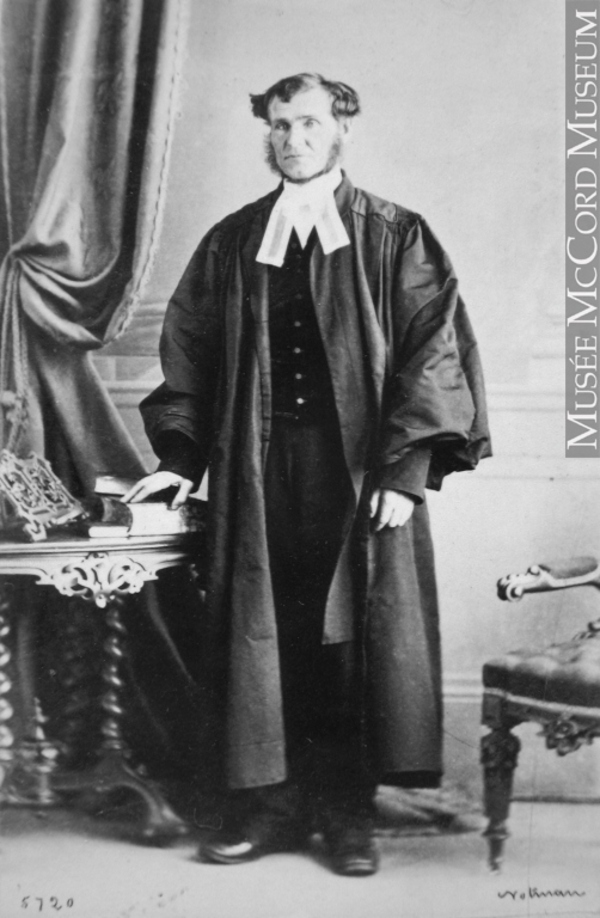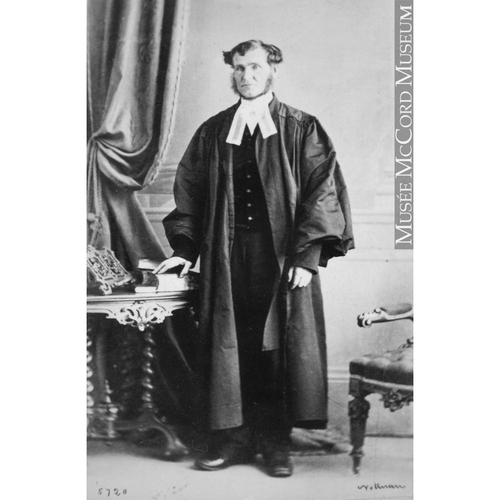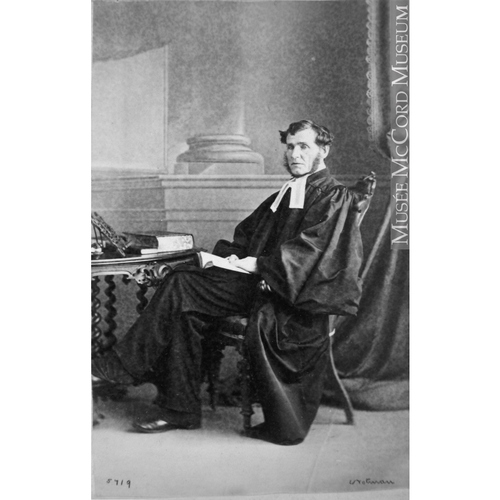
Source: Link
CAUGHEY, JAMES, Methodist minister and evangelist; b. 9 April 1810 in the north of Ireland of Scottish parents; married; d. 30 Jan. 1891 in Highland Park, N.J.
James Caughey was converted to Methodism in a revival during 1830 in Troy, N.Y.; it was to that town that his family had immigrated from Ireland in the early 1820s. Accepted as a preacher on probation in the American Methodist Episcopal Church in 1832, he received deacon’s orders two years later and became a minister at Burlington, Vt. Caughey made his first evangelistic trip to the Canadas in 1835, being involved in a three-month campaign in Montreal. In 1839, while trying to decide whether to marry, he received, he later recorded, a message from God: “These matters which trouble thee, must be let entirely alone. The will of God is, that thou shouldst visit Europe. . . . Visit Canada first; when this is done, sail for England.”
Caughey arrived at Quebec in October 1840, where he tapped into an existing interest in revivalism. He ministered there for three months before going to Montreal. Leaving Montreal in March 1841 and stopping in Saint John, N.B., Caughey made his way to Halifax and sailed to England late in July. He would remain in Britain, enjoying considerable success, until 1847.
By the time of his departure for England Caughey had developed the broad outlines of his theology. He was part of the Holiness movement, which maintained that justification (the forgiveness of one’s sins) and sanctification (being made pure in God’s sight) were gifts that could be received in an instant when the seeker came in faith requesting them from God. Caughey could thus appeal to those who had never been converted for a first commitment, and also to those who had previously made a profession of faith for a recommittal to God in order to receive the fullness of His blessing. This two-pronged thrust meant that very few who heard Caughey could claim that his message was not for them. He blended this theology with great oratorical gifts and an ability to read and react to an audience.
Late in November 1851 Caughey arrived in Toronto, where he stayed for nearly eight months. During that time the membership (the number of people on the class lists) of the Wesleyan Methodist churches in the city grew from 714 to 1,537, an increase that forced the Richmond Street church to start a daughter church on Elm Street in 1853. The Methodists of Toronto were appreciative of Caughey’s work, rallying around him, inviting friends to the services, and providing moral and spiritual support. It is clear that many non-Methodists were also affected by his message, since some 2,000 people were converted during his stay. While in Toronto, Caughey preached seven sermons a week. When not in the pulpit he spent much time alone preparing himself emotionally and spiritually to address the people.
Caughey had been a somewhat controversial figure in Britain, but none of the controversy that had plagued him there followed him to the Canadas. Canadian Methodists were much more willing to accept his evangelistic style and the use of emotionalism than British Methodists, who were concerned about respectability and middle-class values. This is not to say that Canadian Methodists had none of these concerns; rather, they were caught between a desire for middle-class respectability and a hankering for the evangelistic fervour of an earlier period. It was into this milieu that Caughey fit, combining a highly literate message full of classical allusions with a call for a definite response on the part of the individual.
Between 1851 and 1856 Caughey spent from November to March in the Canadas. In the fall of 1852 he visited Kingston, Upper Canada. His impact there was similar to the one he had had in Toronto; both Wesleyan Methodist and Baptist membership grew at unprecedented rates. In March 1853 he went on to Hamilton, arriving in time to speed a developing revival. John Saltkill Carroll*, the Wesleyan Methodist minister there, was thrilled to have him, and the membership doubled as a result of Caughey’s three-and-a-half-month ministry. Caughey returned to the Canadas in the fall of 1853, this time visiting Montreal. He spent the fall and winter of 1854–55 in London, Upper Canada. In December 1855 he went to Belleville on Carroll’s invitation; here he led his last successful Canadian revival campaign. Early in 1856 Caughey went to Brockville, where he had limited success. In 1857 he again visited Britain, remaining there for eight years before returning to Burlington, Vt. Some time later he retired to Highland Park, N.J., in broken health.
Caughey left three marks on Canada and in particular on Canadian Methodism. As the first professional evangelist to visit the Canadas, he prepared the way for future evangelists, providing a model which people such as Dwight Lyman Moody could follow. Secondly, the combined ministry of Caughey and Walter and Phoebe Palmer, lay evangelists from New York who visited Canadian camp meetings between 1852 and 1858, increased the impact of the Holiness movement in Canada. This success opened the door to groups such as the Church of the Nazarene, the Keswick movement, and ultimately the Pentecostal movement. Thirdly, as a result of Caughey’s ministry in Hamilton in 1853 a group of young men decided to become Wesleyan Methodist ministers. They went to Victoria College, Cobourg, and within a year a revival broke out among the students there. Among those affected were Albert Carman* and Nathanael Burwash*, men who would shape the contours of Canadian Methodism beyond the turn of the century.
Caughey thus became a bridge for a large number of Canadians in the 1850s. For recent arrivals from the British Isles he was a bridge to the homeland because of his visits there. For Canadian Methodists he was a bridge between the revivalistic style of an earlier day and the respectability of the present. He provided a way for his listeners to have a base in a past experience while adapting to the realities of an urbanizing society. Like all successful evangelists, Caughey met the people where they were and took them with him to where he was going.
Works by James Caughey examined in the preparation of this biography include the following: Arrows from my quiver; pointed with the steel of truth and winged by faith and love; selected from the private papers of Rev. J. Caughey, intro. Daniel Wise (New York, 1868); Conflicts with skepticism: or, the Christian’s ally in collision with unbelief and unbelievers in the various departments of Christian labor . . . (Boston, 1860; copy at UCC-C); Earnest Christianity illustrated; or, selections from the journal of the Rev. J. Caughey . . . with a brief sketch of Mr. Caughey’s life by the Rev. Daniel Wise (London, [Ont.], 1855); Glimpses of life in soul-saving; or, selections from the journal and other writings of the Rev. James Caughey, intro. Daniel Wise (New York, 1868); Helps to a life of holiness and usefulness, or revival miscellanies . . . selected from the works of the Rev. James Caughey . . . , ed. R. W. Allen and Daniel Wise (Toronto, 1854); Letters on various subjects (5v., London, 1844–47); Methodism in earnest: being the history of a great revival in Great Britain; in which twenty thousand souls were justified, and ten thousand sanctified, in about six years, through the instrumentality of Rev. James Caughey . . . (Boston, 1850); Showers of blessing from clouds of mercy; selected from the journal and other writings of the Rev. James Caughey . . . (Toronto, 1857); and The triumph of truth, and continental letters and sketches, from the journal, letters, and sermons of the Rev. James Caughey . . . (Philadelphia, 1857).
There is no comprehensive bibliography of Caughey’s publications, many of which appeared in multiple editions, but most of them are listed in the British Library general catalogue and the National union catalog; Canadian imprints of three of his titles appear in Biblio. of Canadiana: second supp. (Alston and Evans). Additional works to which the author of this biography has seen references, but which he has not examined, include Parting sermon of the Rev. James Caughey . . . delivered in Sans Street Chapel, Sunderland, on Friday evening Sept. 4, 1846 (Sunderland, Eng., 1846) (cited in Carwardine, below, p.234); Report of a farewell sermon delivered in the Methodist New Connexion Chapel . . . Nottingham, by the Rev. J. Caughey . . . to which is added, an epitome of his farewell address at Sheffield, and an account of his embarkation at Liverpool (Nottingham, Eng., 1847); and A voice from America; or, four sermons . . . reported by a Manchester minister (2nd ed., Manchester, 1847) (copies of the last two items are in the British Library, London).
UCC-C, Nathanael Burwash papers, box 28, files 622–24 (draft autobiography, cc.1–3). Christian Guardian, 1846–60. Richard Carwardine, Transatlantic revivalism: popular evangelicalism in Britain and America, 1790–1865 (Westport, Conn., 1978). Peter Bush, “The Reverend James Caughey and Wesleyan Methodist revivalism in Canada West, 1851–1856,” OH, 79 (1987): 231–50.
Cite This Article
Peter Bush, “CAUGHEY, JAMES,” in Dictionary of Canadian Biography, vol. 12, University of Toronto/Université Laval, 2003–, accessed December 23, 2025, https://www.biographi.ca/en/bio/caughey_james_12E.html.
The citation above shows the format for footnotes and endnotes according to the Chicago manual of style (16th edition). Information to be used in other citation formats:
| Permalink: | https://www.biographi.ca/en/bio/caughey_james_12E.html |
| Author of Article: | Peter Bush |
| Title of Article: | CAUGHEY, JAMES |
| Publication Name: | Dictionary of Canadian Biography, vol. 12 |
| Publisher: | University of Toronto/Université Laval |
| Year of publication: | 1990 |
| Year of revision: | 1990 |
| Access Date: | December 23, 2025 |




